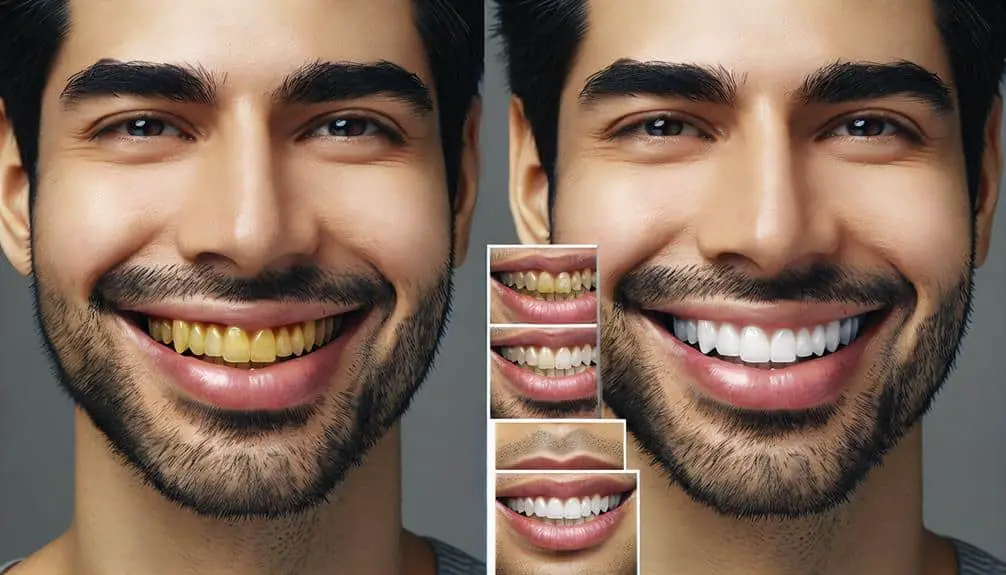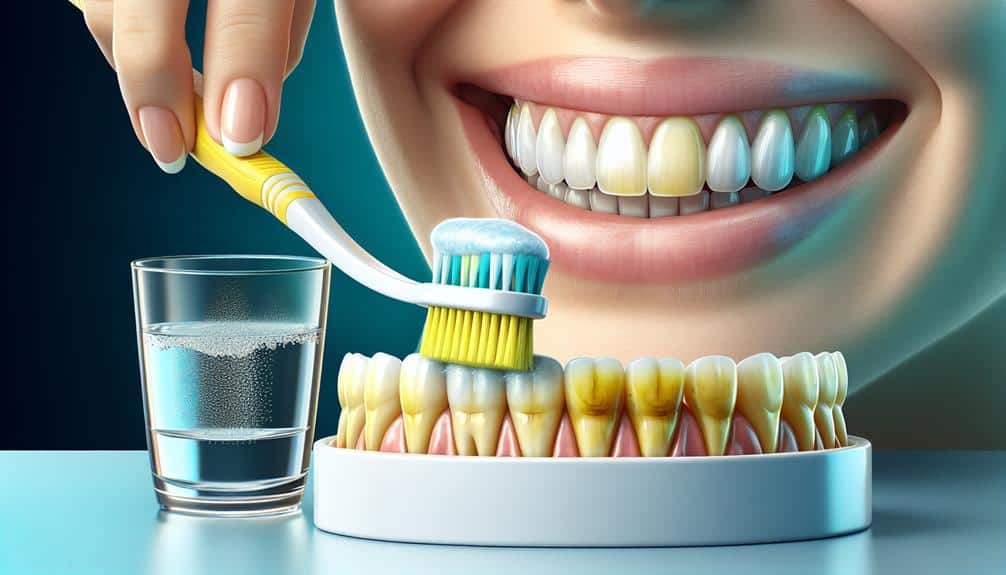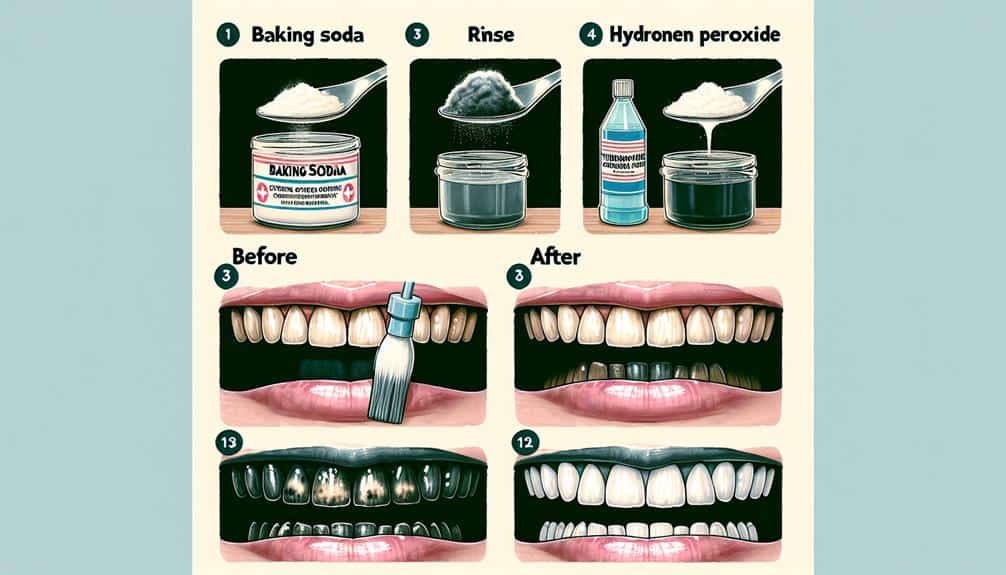To whiten tetracycline-stained teeth effectively, consider professional dental whitening. Dental bleaching breaks down stains using high-concentration gels tailored to your needs. At-home whitening kits offer comparable results when used correctly with consistent maintenance. Whitening toothpaste and mouthwash help remove stains effectively with key ingredients. Natural remedies like baking soda and activated charcoal can gently whiten teeth. Laser treatments are precise and efficient for noticeable results. Whitening trays and gels with lower concentrations are gentle on teeth. Explore cosmetic dentistry options for deep stain removal. Achieve a brighter smile by exploring these seven best methods for whitening stained teeth.
Key Points
- Professional dental whitening effectively tackles tetracycline stains with high-concentration bleaching gels.
- At-home whitening offers convenience but may require more time for noticeable results.
- Consider cosmetic dentistry options like veneers for extensive smile makeovers.
- Laser teeth whitening provides quick and precise stain removal with less post-treatment sensitivity.
- Natural remedies like activated charcoal and oil pulling can help whiten tetracycline-stained teeth.
Professional Dental Whitening
To effectively address tetracycline-stained teeth, professional dental whitening treatments offer a reliable solution for achieving a brighter and whiter smile. Dental bleaching procedures are commonly used by dentists to combat the stubborn stains caused by tetracycline. These techniques involve the application of bleaching agents to the teeth, breaking down the stains and restoring the natural color of the enamel.
Professional dental whitening procedures are carried out in a controlled environment by trained professionals, ensuring safety and efficacy. Dentists use high-concentration bleaching gels or light-activated systems to accelerate the whitening process. These methods provide a more effective whitening effect compared to over-the-counter products.
Teeth bleaching techniques offered by dental professionals are tailored to the individual needs of patients. The dentist will assess the severity of the stains and customize the treatment plan accordingly. Multiple sessions may be required to achieve optimal results, depending on the extent of discoloration. Overall, professional dental whitening is a proven method for effectively whitening tetracycline-stained teeth.
At-Home Whitening Kits
When evaluating at-home whitening kits for tetracycline-stained teeth, it's essential to compare their effectiveness to professional dental whitening treatments.
Remember to follow application process tips carefully to achieve best results.
Consistent maintenance is key to ensuring long-lasting whitening results.
Kit Effectiveness Comparison
Comparing the effectiveness of at-home whitening kits is essential for individuals seeking to whiten tetracycline-stained teeth effectively.
DIY whitening methods often come with a lower cost compared to professional treatments, making them an attractive option for many. However, it's important to weigh professional vs. at-home results and satisfaction rates.
At-home whitening kits typically offer convenience but may require more time and consistent use to achieve desired results. Professional treatments, while pricier, may provide quicker and more noticeable changes.
Consider your goals, budget, and time constraints when deciding between at-home kits and professional whitening services to guarantee the best outcome for your tetracycline-stained teeth.
Application Process Tips
For best outcomes with at-home whitening kits on tetracycline-stained teeth, mastering the application process is essential.
When using whitening strips, proper technique is important. Make sure the strips cover the stained areas evenly and avoid contact with the gums to prevent irritation.
Additionally, when it comes to peroxide application, timing is key. Follow the recommended guidelines for how long to keep the product on your teeth to achieve ideal results without causing harm.
Consistency in following the application instructions is crucial for effective whitening. Remember, patience is essential, and rushing the process can lead to uneven whitening or tooth sensitivity.
Maintenance and Results
To maintain the results achieved with at-home whitening kits for tetracycline-stained teeth, consistent follow-up care is essential. Long-term results rely on proper maintenance and preventative care.
After completing the initial whitening regimen, it's important to follow up with touch-ups as needed to sustain the desired level of whiteness. Touch-up treatments can help combat new stains and maintain the brightness of your teeth over time.
Additionally, practicing good oral hygiene such as regular brushing, flossing, and dental check-ups can contribute to prolonging the effects of the whitening treatment.
Whitening Toothpaste and Mouthwash
When choosing whitening toothpaste and mouthwash, consider their effectiveness in removing stains and brightening your teeth. Whitening toothpaste can help polish your teeth and remove surface stains, while whitening mouthwash can reach areas that are difficult for toothpaste to access.
Follow the usage instructions provided with these products to achieve the best results in improving the appearance of your teeth.
Toothpaste Effectiveness
Using whitening toothpaste and mouthwash can effectively help in brightening tetracycline-stained teeth. When selecting whitening toothpaste, look for ingredients like hydrogen peroxide, baking soda, or fluoride to enhance whitening results.
Proper brushing techniques are essential; make sure you brush for at least two minutes, covering all tooth surfaces, and use gentle circular motions to prevent enamel damage. For best stain removal, consider using a toothbrush with soft bristles to avoid abrasive effects on the teeth.
Additionally, incorporating mouthwash into your oral care routine can further aid in eliminating stains and freshening breath. Always follow product instructions and maintain consistency to achieve the most favorable results.
Mouthwash Benefits
Enhance your oral care routine by incorporating mouthwash to experience the whitening benefits of whitening toothpaste and mouthwash. Mouthwash benefits extend beyond fresh breath; it can also play an essential role in maintaining good oral health.
The effectiveness of mouthwash lies in its unique combination of ingredients, such as fluoride, essential oils, and hydrogen peroxide. These components work together to combat bacteria, reduce plaque, and freshen breath. When used in conjunction with whitening toothpaste, mouthwash can enhance the overall whitening effects on tetracycline-stained teeth.
To maximize the benefits, choose a mouthwash that's specifically formulated for whitening and maintaining oral health. By incorporating mouthwash into your daily routine, you can achieve a brighter, healthier smile.
Usage Instructions
For best results, follow these usage instructions for whitening toothpaste and mouthwash.
- Whitening Toothpaste:
- Squeeze a pea-sized amount onto a soft-bristled toothbrush.
- Brush teeth gently in a circular motion for two minutes.
- Rinse thoroughly with water.
- Mouthwash:
- Pour the recommended amount into a cup.
- Swish around your mouth for 30-60 seconds.
- Avoid eating or drinking for 30 minutes after use.
When using whitening strips, always read the precautions and follow the instructions carefully. For over the counter options, consult your dentist for recommendations. Remember, consistency is key to achieving the best results.
Natural Remedies for Whitening
To naturally whiten tetracycline-stained teeth, consider incorporating these proven home remedies into your oral care routine. For a cost-effective approach, DIY recipes using common household ingredients can be remarkably effective. Baking soda, for example, can gently scrub away surface stains, while a mixture of hydrogen peroxide and water can act as a natural whitening agent.
Herbal solutions like activated charcoal have gained popularity for their ability to absorb toxins and stains from the teeth, providing a natural route to a brighter smile. Additionally, oil pulling with coconut oil is believed to reduce bacteria in the mouth and promote whiter teeth over time.
Laser Teeth Whitening
Consider laser teeth whitening as a modern and efficient method to achieve a brighter smile. Laser treatment benefits include:
- Precision: The focused laser can target specific areas, providing precise whitening results.
- Speed: The procedure is usually quick, with many patients seeing noticeable results after just one session.
- Less Sensitivity: Compared to traditional whitening methods, laser treatments often result in less tooth sensitivity post-treatment.
During the procedure, a protective barrier is applied to your gums to shield them from the laser. A peroxide-based gel is then applied to your teeth, which the laser activates to speed up the whitening process. The laser energy penetrates the enamel to break up stains and discoloration. Multiple sessions may be needed for optimal outcomes, depending on the severity of staining. Consult with a dental professional to determine if laser teeth whitening is the right choice for you.
Whitening Trays and Gels
Utilize whitening trays and gels for a vital at-home method to enhance the brightness of your teeth. Whitening trays are custom-fitted to your teeth, ensuring even application of the whitening gel. These trays, when paired with professional-grade whitening gels, can effectively reduce tetracycline stains.
When using whitening gels, it's important to be mindful of gel sensitivity and take preventive measures. To prevent potential sensitivity, opt for gels with lower concentrations of whitening agents and follow the recommended usage guidelines provided by your dentist. Additionally, consider using desensitizing toothpaste to alleviate any discomfort that may arise during the whitening process.
While whitening trays and gels offer a convenient and cost-effective solution for tackling tetracycline stains, it's crucial to explore alternatives like whitening strips for a more targeted approach to specific areas of staining. By incorporating these strategies and being proactive about gel sensitivity prevention, you can achieve noticeable results in brightening your smile from the comfort of your home.
Cosmetic Dentistry Options
Explore the various cosmetic dentistry options available to enhance the appearance of your teeth and achieve your desired smile transformation.
- Teeth Bleaching: One of the most common and effective methods to whiten tetracycline-stained teeth is through professional teeth bleaching. This process uses powerful bleaching agents to remove deep stains and discoloration, giving you a brighter smile.
- Veneers: For a more extensive smile makeover, veneers are a popular choice. These thin shells, usually made of porcelain, are custom-designed to cover the front surface of your teeth, masking stains and improving the overall appearance of your smile.
- Dental Bonding: Dental bonding is a versatile cosmetic dentistry option that can address tetracycline stains by applying a tooth-colored resin to the affected teeth. This procedure can effectively cover stains and reshape teeth, providing a natural-looking and seamless smile transformation.
When considering cosmetic dentistry options for tetracycline-stained teeth, consult with a qualified dentist to determine the best approach for achieving the radiant smile you desire.
Frequently Asked Questions
Are There Any Dietary Restrictions or Habits That Should Be Avoided When Trying to Whiten Tetracycline-Stained Teeth?
To prevent interference with whitening efforts for tetracycline-stained teeth, avoid foods like coffee and red wine known for staining. Opt for natural remedies like baking soda and hydrogen peroxide to gently brighten your smile.
How Long Do the Results of Teeth Whitening Typically Last for Tetracycline-Stained Teeth?
For tetracycline-stained teeth, the longevity of whitening results varies based on treatment methods and maintenance. Effective whitening can last for several months to a few years. Consistent care, follow-up treatments, and avoiding staining habits contribute to long-term success.
Can Tetracycline-Stained Teeth Be Effectively Whitened for Individuals With Sensitive Teeth or Gums?
When considering whitening for tetracycline-stained teeth, individuals with tooth sensitivity may find effectiveness varies. Address gum sensitivity by exploring alternatives like gentle whitening products or consulting a dentist for tailored solutions to achieve desired results safely.
Are There Any Potential Side Effects or Risks Associated With Whitening Tetracycline-Stained Teeth?
Potential risks associated with whitening tetracycline-stained teeth include increased tooth sensitivity. It's important to consult your dentist before starting any whitening treatment to minimize these risks. Protect your smile by prioritizing professional guidance.
How Does the Cost of Whitening Tetracycline-Stained Teeth Compare Between Professional Dental Treatments and At-Home Whitening Kits?
When comparing the cost of whitening tetracycline-stained teeth, professional dental treatments usually cost more upfront but can provide faster and more effective results. At-home whitening kits are generally more affordable but may take longer to achieve noticeable improvements.



